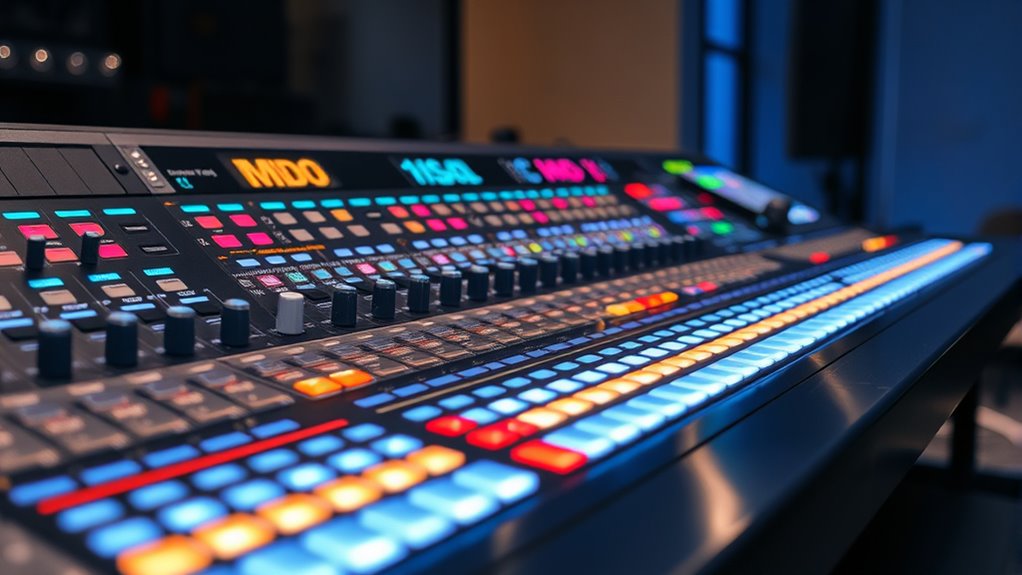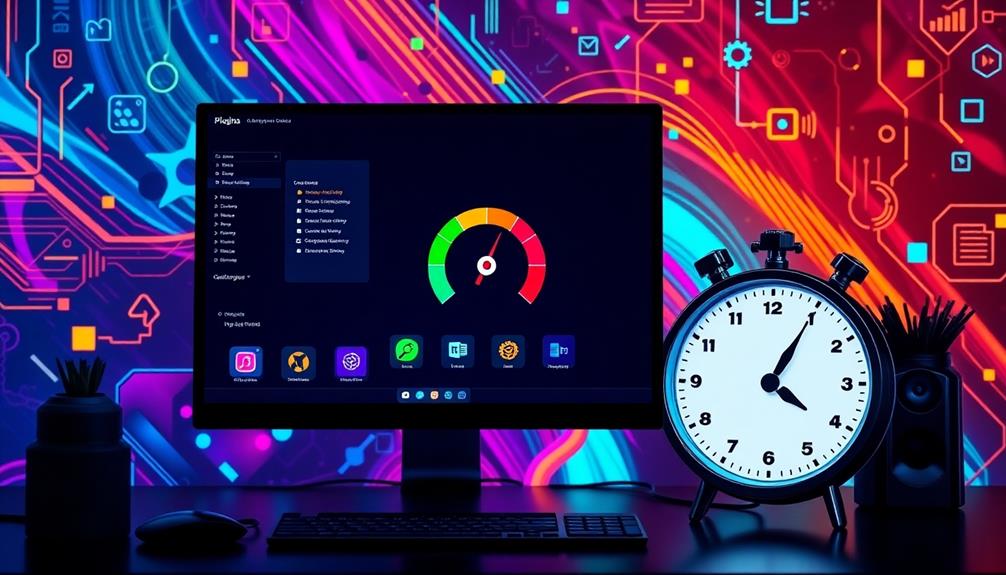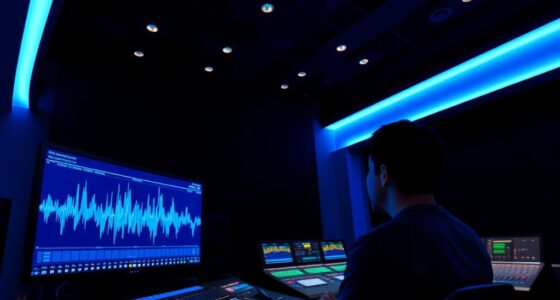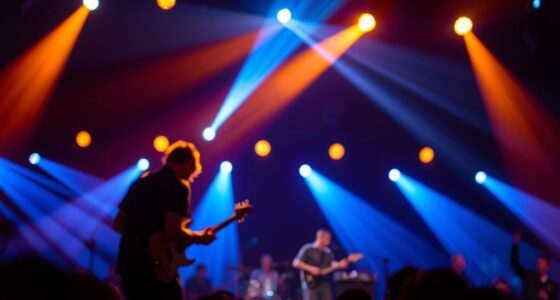Show control systems use protocols like MIDI, OSC, and timecode to synchronize lighting, sound, and effects seamlessly during performances. MIDI is great for controlling instruments and basic cues, while OSC offers more detail and flexibility for complex setups. Timecode acts as the master clock, ensuring perfect timing across devices. Mastering these protocols helps you create precise, dynamic shows. Keep exploring to learn how each protocol can elevate your productions to the next level.
Key Takeaways
- MIDI, OSC, and Timecode are communication protocols used to synchronize and control lighting, sound, and effects in show control systems.
- MIDI transmits simple control messages between electronic devices, often for triggering cues or scenes.
- OSC provides high-resolution, flexible messaging for complex, precise control over lighting fixtures and multimedia systems.
- Timecode serves as a master clock to ensure perfect timing and synchronization across multiple devices during a performance.
- Mastering these protocols enables seamless automation, accurate cue execution, and enhanced coordination in stage productions.
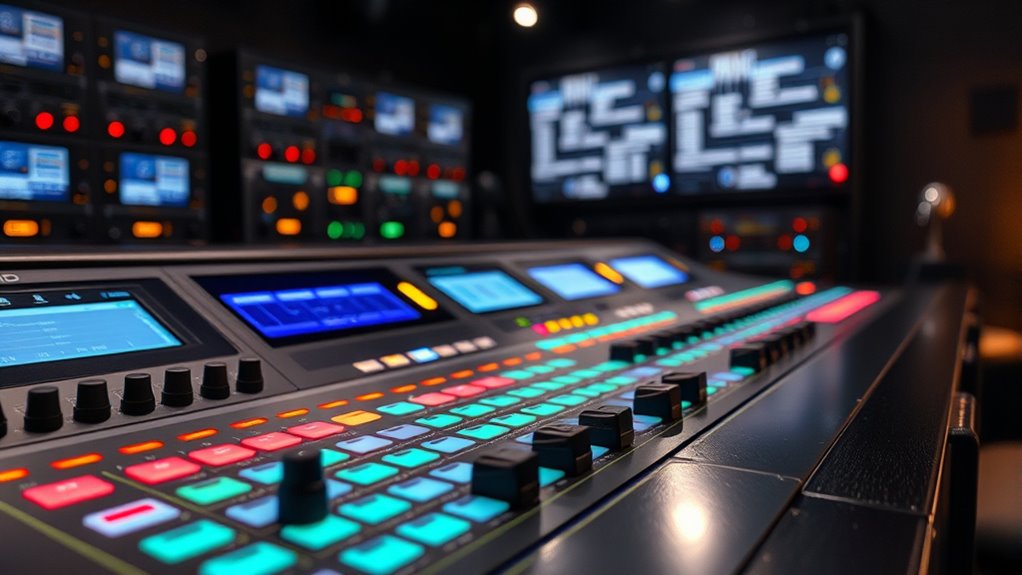
Have you ever wondered how elaborate stage productions synchronize lighting, sound, and effects seamlessly? It’s all about show control, where technology orchestrates every element to create a cohesive performance. One of the key aspects of this process is lighting automation, which allows lighting cues to be triggered precisely at the right moments. When you’re involved in show programming, you set up these cues to ensure that the lights change color, intensity, and position exactly as the scene demands. This automation eliminates the need for manual operation during the show, reducing errors and maintaining consistency. By programming lighting sequences in advance, you can craft complex lighting designs that enhance the mood, focus attention, and support the narrative without any hiccups.
Show programming is the backbone of effective show control. It involves designing sequences for lighting, sound, and effects, then linking them to specific cues or triggers. These triggers can come from various sources like MIDI, OSC, or timecode, each serving a different purpose. MIDI, for example, is a protocol that allows electronic instruments and controllers to communicate with lighting and sound systems. When you use MIDI in your show programming, you can assign commands to MIDI signals, which can be sent from a control surface or a computer to activate specific lighting scenes or sound effects. This creates a dynamic and flexible environment where changes can be made quickly, and cues can be synchronized across multiple systems.
OSC, or Open Sound Control, is another protocol that’s gaining popularity for show control. It offers more versatility and higher resolution than MIDI, making it ideal for controlling complex lighting automation and multimedia setups. With OSC, you can send detailed messages that tell your lighting fixtures exactly how to behave, adjusting parameters in real-time. When integrating OSC into your show programming, you gain the ability to coordinate multiple devices and software seamlessly, creating more immersive and interactive experiences.
Timecode is often used when precise synchronization is necessary, especially in large productions or multimedia performances. It acts like a master clock, providing a timestamp that all systems follow to keep everything in perfect sync. As you program your show, you link cues to specific timecode values, ensuring that lighting, sound, and effects happen precisely when needed. This level of precision is vital for complex performances where timing is everything.
In essence, mastering show programming and understanding these protocols—MIDI, OSC, and timecode—empowers you to create flawless performances. By leveraging lighting automation and these control methods, you can produce shows that are visually stunning, perfectly timed, and technically synchronized down to the millisecond. Additionally, understanding the contrast ratio of your equipment can help you optimize visual elements for clarity and impact, especially in multimedia-rich productions.
Frequently Asked Questions
How Do I Choose Between MIDI, OSC, and Timecode for My Project?
You choose between MIDI, OSC, and Timecode based on your project’s protocol compatibility and system integration needs. If you need simple, widely-supported control for musical instruments or lighting, go with MIDI. For more flexible, high-resolution communication over networks, OSC is ideal. If precise timing synchronization is critical, especially for video and multimedia, Timecode is the best option. Consider your devices and desired control complexity to make the right choice.
What Are Common Troubleshooting Steps for Show Control Synchronization Issues?
When troubleshooting show control synchronization issues, first check your equipment calibration to make certain all devices are correctly set. Next, verify network stability by inspecting connections and reducing interference. Restart devices if needed, update firmware, and confirm proper configuration of MIDI, OSC, or timecode settings. These steps help identify common issues and restore smooth synchronization, keeping your show running seamlessly.
Can These Protocols Be Integrated With Existing Lighting and Sound Systems?
You can absolutely integrate these protocols with your existing lighting and sound systems! Don’t worry about legacy integration—many modern control systems are designed for protocol compatibility, making upgrades seamless. By ensuring your equipment supports MIDI, OSC, or Timecode, you access incredible synchronization power. It’s like giving your show superpowers, allowing your lighting and sound to work together flawlessly, creating a breathtaking experience that feels like pure magic.
What Are the Security Considerations When Using Networked Show Control Protocols?
When using networked show control protocols, you should prioritize network security by implementing strong measures like protocol encryption to protect your system from unauthorized access. Regularly update firmware, use secure passwords, and segment your network to limit vulnerabilities. These steps help prevent hacking or interference, ensuring your show runs smoothly. Remember, safeguarding your control protocols is vital for maintaining the integrity and safety of your entire production.
How Do I Update or Upgrade Show Control Software Without Disrupting Performances?
Updating your show control software is like tuning an instrument—smooth and precise. You should first perform firmware updates during scheduled downtime to avoid disruptions. Always follow backup procedures to save your current setup, ensuring you can restore everything if needed. Use a staged approach: test updates in a sandbox environment, then deploy during low-traffic times. This way, your performances stay seamless and your show stays on cue.
Conclusion
Now that you’ve got the basics down, you’re ready to take your show to the next level with MIDI, OSC, and timecode. Think of these tools as your backstage crew, seamlessly coordinating every cue and movement—no need for a crystal ball, just smart tech. Remember, even in a world of digital wizardry, sometimes a little bit of old-school timing (like a vintage clock) can make all the difference. You’re all set to create unforgettable, synchronized performances!

